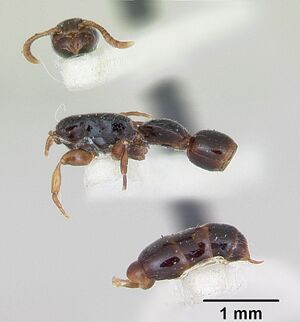Simopone chapmani
| Simopone chapmani | |
|---|---|

| |
| Scientific classification | |
| Kingdom: | Animalia |
| Phylum: | Arthropoda |
| Class: | Insecta |
| Order: | Hymenoptera |
| Family: | Formicidae |
| Subfamily: | Dorylinae |
| Genus: | Simopone |
| Species group: | grandidieri |
| Species: | S. chapmani |
| Binomial name | |
| Simopone chapmani Taylor, 1966 | |
Known only from the holotype, nothing is known about the biology of Simopone chapmani.
Identification
A member of the grandidieri species group. The species was compared to Simopone gressitti by Taylor (1966) but the following features of chapmani deserve mention. Antennal scrobe narrow but deep, apex of scrobe deflected ventrally as a triangular impression immediately in front of the anterior margin of the eye; scape very short, SI 33; metapleuron traversed by a sulcus that continues the line of the mesopleural sulcus; AII distinctly longer than broad (AIIW/AIIL 0.86); side of AII without a curved longitudinal carina between the dorsolateral margin and the level of the spiracle; AII longer than AIII in dorsal view; AIII longer than postergite of AIV. (Bolton and Fisher 2012)
Keys including this Species
Distribution
Latitudinal Distribution Pattern
Latitudinal Range: 10° to 10°.
| North Temperate |
North Subtropical |
Tropical | South Subtropical |
South Temperate |
- Source: AntMaps
Distribution based on Regional Taxon Lists
Indo-Australian Region: Philippines (type locality).
Distribution based on AntMaps
Distribution based on AntWeb specimens
Check data from AntWeb
Countries Occupied
| Number of countries occupied by this species based on AntWiki Regional Taxon Lists. In general, fewer countries occupied indicates a narrower range, while more countries indicates a more widespread species. |

|
Estimated Abundance
| Relative abundance based on number of AntMaps records per species (this species within the purple bar). Fewer records (to the left) indicates a less abundant/encountered species while more records (to the right) indicates more abundant/encountered species. |

|
Biology
|
Castes
Images from AntWeb
  
| |
| Holotype of Simopone chapmani. Worker. Specimen code casent0173044. Photographer April Nobile, uploaded by California Academy of Sciences. | Owned by MCZ, Cambridge, MA, USA. |
Nomenclature
The following information is derived from Barry Bolton's Online Catalogue of the Ants of the World.
- chapmani. Simopone chapmani Taylor, 1966b: 287 (w.) PHILIPPINES (Negros I.).
- Type-material: holotype worker.
- Type-locality: Philippines: Negros I., Horns of Negros, 3600 ft (J.W. Chapman).
- Type-depository: MCZC.
- Status as species: Brown, 1975: 35; Radchenko, 1993b: 47 (in key); Bolton, 1995b: 383; Bolton & Fisher, 2012: 71; Chen, Zhou & Liang, 2015: 9 (in key); Chen, Chen & Zhou, 2019: 29 (in key).
- Distribution: Philippines (Negros).
Unless otherwise noted the text for the remainder of this section is reported from the publication that includes the original description.
Description
Dimensions (in mm): aggregate total length (TL) ca. 5.0; head length at midline (HL) 0.91; maximum head width (HW) 0.68; cephalic index (HW X 100/HL) (CI) 75; maximum eye diameter 0.30; ocular index (eye diameter X 100/HW) (OI) 44; minimum interocular distance 0.34 (1.14 X eye diameter); PW 0.55; WL 1.2; petiolar node length at midline 0.68; maximum petiolar node width 0.56; postpetiolar length at midline 0.64; maximum postpetiolar width 0.61. Generally similar to the New Guinean S. gressitti Taylor, and agreeing with its original description (Taylor, 1965, Ereviora 221: 3), except in the following characters:
1. Smaller size, with narrower head and proportionately large eyes, which are less widely separated relative to their maximum diameter; postpetiole slightly longer than broad in dorsal view (length 1.05 X width). (The relevant dimensions of gressitti are: TL ca. 6.4 mm; CI 81; OI 38; eyes separated by 1.53 x their maximum diameter; postpetiole length 0.70 mm, width 0.75 mm — length 0.93 X width.)
2. Transverse occipital carina lacking distinct ribs along its anterior edge.
3. Lateral suturation of mesosoma complete, but less distinct. Transverse ribbing vestigial on dorsal promesonotal suture and lacking on dorsal mesometanotal suture.
4. Transverse anterior petiolar carina without ribs.
5. Sides of postpetiole, in dorsal view, almost parallel, very feebly divergent posteriorly.
6. Body entirely smooth and shining, except for some vestigial fine longitudinal striae on frontal carinae, and scaly microsculpture on sides of pronotum and propodeum, and on metepisternal areas.
7. Post-cephalic ground pilosity more abundant. Very fine short reclinate to suberect hairs scattered on dorsum of mesosoma, most abundant on sides of propodeal dorsum. Similar pilosity moderately abundant on dorsa of petiole and postpetiole. Single, more erect, but barely longer hairs at mid length of each frontal carina and above each eye, but not elsewhere. No subpetiolar "brush" developed; only 2 hairs break the subpetiolar profile.
The mandibular dentition is worn but was probably originally like that of bakeri, as described by Menozzi. The legs are damaged; so details of the tibial and tarsal armament are not known.
Type Material
Bolton and Fisher (2012) - Holotype worker, PHILIPPINES: Negros I., Horns of Negros, 3600 ft. (J.W. Chapman) (Museum of Comparative Zoology) [examined]. The holotype and only known specimen of this species is fragmented and mounted on three card triangles on a single pin: head on top triangle, mesosoma + AII + AIII on middle triangle, AIV to apex on bottom triangle.
References
- Bolton, B. & Fisher, B.L. 2012. Taxonomy of the cerapachyine ant genera Simopone Forel, Vicinopone gen. n. and Tanipone gen. n. (Hymenoptera: Formicidae). Zootaxa 3283, 1–101 (doi:10.11646/zootaxa.3283.1.1).
- Taylor, R. W. 1966b [1965]. Notes on the Indo-Australian ants of genus Simopone Forel (Hymenoptera-Formicidae). Psyche (Camb.) 72: 287-290.
References based on Global Ant Biodiversity Informatics
- Borowiec M. L. 2016. Generic revision of the ant subfamily Dorylinae (Hymenoptera, Formicidae). ZooKeys 608: 1–280.
- Chen Z., Y. Chen Y, and S. Zhou. 2019. Simopone fisheri sp. n., a new species of Dorylinae ants (Hymenoptera, Formicidae) from China, with an illustrated key to the S. grandidieri-group species. ZooKeys 838: 21–33.


